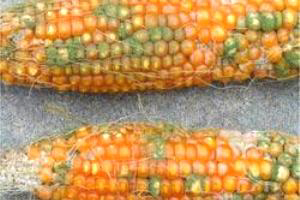Prevent mycotoxins at the source

Moulds and mycotoxins in feed can negatively impact nutrient quality and nutrient digestion, resulting in poor animal performance, warns Anitox Chief Science Officer Dr Kurt Richardson.
“The impact of mould on the nutrient quality of feed is often overlooked. It should be realised that as moulds propagate, they utilise the nutrients in the feed to sustain their growth. This can result in lower levels of carbohydrates, fats, amino acids and vitamins available to the animal through the feed. When the animal consumes this nutrient deficient feed, body weight gain can decrease and feed conversion efficiency is poorer,” explains Dr Richardson. Certain species of yeast, such as Candida, can colonise the crop and proventriculus of poultry. Candida is known to cause vitamin A deficiencies. It can also result in ventricular lesions, which result in poor nutrient absorption.
Mycotoxins are secondary metabolites of mould and impact both nutrient digestion and absorption. It has been shown that poultry consuming aflatoxin-contaminated feed have lower levels of pancreatic enzymes, such as lipase, amylase, trypsin and chymotrypsin. These enzymes are necessary to digest the carbohydrates, fats and proteins in the feed. Aflatoxin and other mycotoxins can also affect the liver and result in hepatic dysfunction. Both fats and pigment distribution to the tissue can be affected, in addition to the enzymes involved in vitamin D synthesis.
Other mycotoxins such as T-2 toxin and DAS cause intestinal lesions, which impacts the absorption of nutrients. It is quite common to observe undigested feed particles in the manure of animals that have consumed mycotoxin contaminated feed. This symptom is often referred to as feed passage. “It’s crucial that we prevent mycotoxins at source; prevent the mould, eliminate the mycotoxin threat.”
Dr Richardson advises: “Keep storage areas dry and regularly check moisture levels in high-risk areas. To ensure your feed is fully protected, choose a chemical mould inhibitor such as Punch™ to protect feed nutrient values, palatability and performance, and protect the producer’s investment in feed.”
Author:
Anitox











